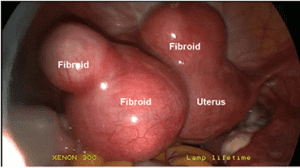Uterine fibroids, medically called leiomyoma, are benign tumors of the uterus. They may range in size from microscopic to as large as the size of basketball or bigger. Approximately 20 to 25% of women in reproductive age are affected by fibroids, and this incidence may go up to 40% in women who are older than 40. Patients who had their first menstrual period at the younger age, or with later than normal menopause, are at higher risk for fibroids. Fibroid tumors are the most common in African American women, and least common in women of Asian descent. They are also more common in women who have a first degree relative with fibroids.
The most common symptoms fibroids is abnormal, sometimes very heavy vaginal bleeding, heaviness, pelvic pressure. Occasionally patients may also experience the frequency of urination. Fibroids rarely cause pain but often lead to discomfort during intercourse or physical activity.
Fibroids can be diagnosed on gynecological exam but the size and location is usually confirmed with an ultrasound or MRI.

Treatment of fibroids may be medical, using interventional radiology techniques, or surgical. If fibroids are found during routine exam and they do not cause any symptoms one of the choices would be to do nothing and wait to see if fibroids increase in size or become symptomatic. It is important to remember that fibroids increase in size before menopause so delaying treatment for too long may make it more difficult. Uterine fibroids very rarely become malignant, so presence of fibroids without symptoms is not an indication for surgery. Medical treatments are designed to decrease the level of estrogens and to trigger the fibroids to shrink. It is done by using anti-estrogen oral medications or injections. Patients undergoing those treatments may experience significant menopausal side effects from low estrogen levels. Also, within few months of stopping this treatment, fibroids may regain their original size. Hormonal treatment is therefore rarely a permanent fix. Fibroids may also be treated with interventional radiology by plugging the vessels which feed blood to the fibroid. This treatment is quite painful and may have a risk of compromising blood supply to the whole uterus or other internal organs. Embolization of fibroids may also increase the risk to future pregnancy.
Surgical procedures include minimally invasive myomectomy or minimally invasive hysterectomy. Myomectomy is a procedure in which fibroids are separated from the uterus and remaining uterus is reconstructed to allow for future pregnancy. It can be performed using surgical robot even with the large size fibroids therefore avoiding large abdominal incision. Some patients who completed the childbearing may choose to have a minimally invasive hysterectomy. It potentially allows for faster recovery and return to work then in patients undergoing myomectomy. Also, because fibroids tent to reoccur, hysterectomy decreases the risk of future pelvic surgery.


If you or anyone you know has symptomatic uterine fibroids, contact our office at 480 599-9682 or email [email protected] to learn about available treatments.
